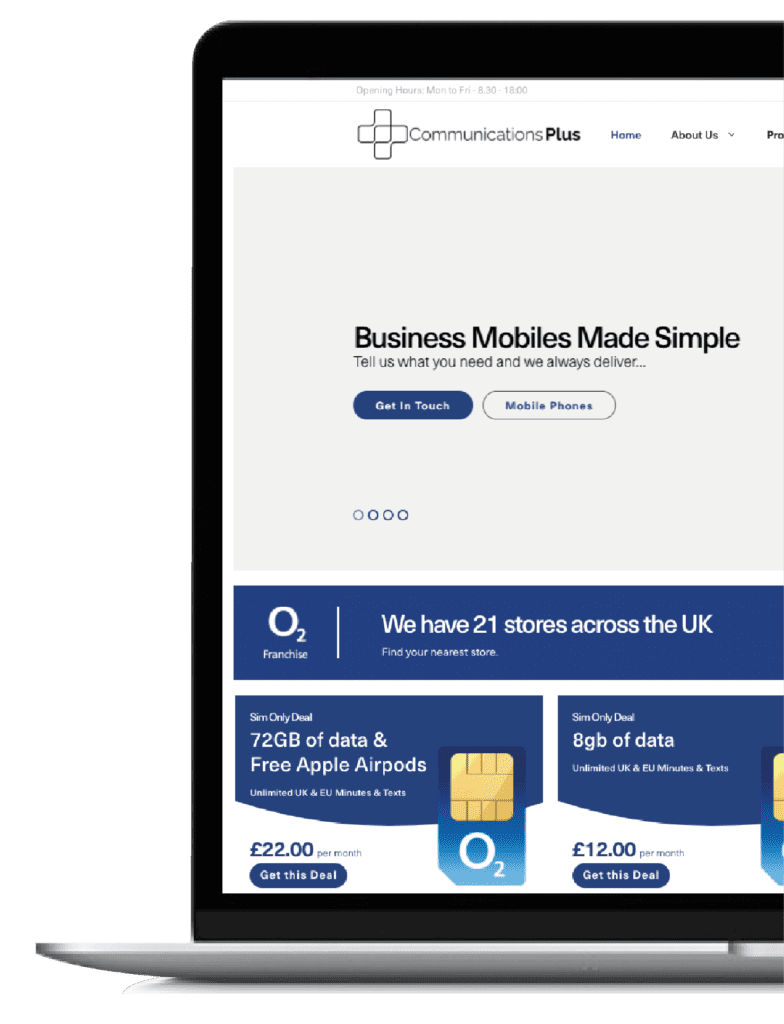Connectivity and real-time communication are crucial for businesses.
One answer is Enterprise Mobility Management (EMM).
Enterprise Mobility Management makes it easier to share information securely across mobile devices, so your workforce can operate from anywhere.
As the number of people using smartphones continues to increase year on year, so will the number of people using these devices for work.
More than 80% of employees already use a smartphone as part of their work.
Businesses need mobility management software to keep up.
What is Enterprise Mobility Management?
Enterprise Mobility Management is all about securely distributing data wherever employees access it from.
It’s a kind of umbrella term for all the processes and technology that go into protecting business mobile devices.
There are security procedures for all devices like smartphones, tablets, and laptops, and the people who access them.
It involves managing remotely stored information (usually cloud-based) and endpoint management on the physical devices.
EMM is the mobility solution that covers the most bases, because it combines multiple types of mobility solutions to create an all-encompassing service.
It’s an extremely influential movement for accelerating business growth.
With the Enterprise Mobility Management market estimated to be worth almost £9 billion by 2025 and remote working on the rise, now is as good a time as any to invest in EMM for business mobile phones.
How Enterprise Mobility Management works
EMM is not just for improving flexibility and productivity for workers. It should protect your business against data loss and unauthorised access.
Enterprise mobility management is the overall term for a collection of specific mobility management solutions.
Its goal is to integrate mobile IT with work objectives so employees can do their jobs well in the workplace and outside of it.
It combines separate services like:
- Mobile Device Management (MDM) for enforcing security policies on devices
- Mobile Application Management (MAM) for managing apps and software installed on devices
- Mobile Information Management (MIM) for ensuring appropriate access permissions for each employee
- Mobile Content Management (MCM) for controlling access to and storage of corporate data
- Mobile Expense Management (MEM) for overseeing data and roaming costs
The basic version of EMM should include MDM, MAM, and MIM at least.
Different EMM solutions might offer varying combinations of all the management components.
It’s up to each business to decide which levels they need to allow their employees to work from wherever while reducing security risks.
Enterprise Mobility Management’s core functions include:
- Bring Your Own Device (BYOD) policies
- Ability to configure all devices remotely
- Encrypting mobile data
- Enforcing password locks on devices
- Conditional access and single sign-on (SSO) management
- Monitoring and updating applications
- Tracking mobile security threats
- Remote wiping of compromised devices
If you allow employees to work on mobile devices without these measures in place, you’ll be opening your business up to malware attacks and data theft.
Why you should use Enterprise Mobility Management
Small to medium businesses use mobile technology almost as extensively as larger enterprises, making mobility management vital for businesses of all sizes.
Portable devices require the same security levels as every office-based device
Any industry with employees using mobile devices should invest in resources to manage them securely.
Losing data causes extensive damage to your reputation and your finances if you have to pay a penalty for breaching data protection laws.
It’s not worth the risk not updating your security network.
Enterprise Mobility Management is so important for businesses because it enhances security while simplifying the management of devices and their users.
Integrating business mobile phones and other devices into a corporate network is so much easier with EMM.
Implementing Enterprise Mobility Management can drastically improve your business:
- Real-time data access leads to faster analysis and better decisions.
- Distributing resources more efficiently lowers costs and improves customer satisfaction, increasing profits.
- Greater cross-level communication results in more effective collaboration and keeps employees up to date.
- Clear device use policies can prevent internal security incidents, too.
There are so many benefits of Enterprise Mobility Management that you can read more about below.
Main benefits of Enterprise Mobility Management
The primary benefits of EMM are advanced security and increased accessibility.
But these cover an extensive range of individual assets, like:
- Enforcing password policies
- Employee profiles to determine application access
- Remote data wiping in case of loss or theft
- Real-time geolocation
- Accurate data collection
- Data protection compliance
- Centralised system for easy management all in one place
- Servicing multiple device and operating system types
- Remote installations and upgrades
- Troubleshooting support (reducing dependency on IT department)
- Reduced operational costs with time savings
- Increased employee engagement and productivity
- Improved user satisfaction
Enterprise Mobility Management empowers employees, saves money, and protects information.
The peace of mind it offers is priceless.
How to set up Enterprise Mobility Management
Mobile applications and their management solutions won’t replace everything in your business.
You’ll need to integrate them with your existing policies and make sure they align with your future development objectives.
Identifying your business needs is an important part of making your Enterprise Mobility Management strategy successful.
Before deploying EMM, everyone should already know how they’re expected to use it.
And before you even settle on an EMM provider, you’ll need to ask yourself some important questions about:
- The core services of your business
- Where you want your business to be in the next 5 to 10 years
- Who is responsible for developing your EMM strategy
- Which management solutions you need under EMM
- How you’d comply with local industry regulations
- Who needs to access your data and how they’ll access it
- Whether you need different access levels for different people
- Which operating systems you’ll need to support
- Potential bottlenecks or pain points for users
- How you’d deploy EMM (on-premises or cloud software)
There’s a lot to think about before you even get started. Even the best EMM service is nothing without a strong policy to govern its usage, so always start there.
Your EMM tools must be easy for employees to use and meet the standards you set out at the beginning.
Choose your EMM software, update any existing policies or carefully create new ones, and implement EMM with the help of your provider when you’re ready.
It’s a good idea to do a small pilot run before full deployment to identify any immediate issues.
And don’t forget to regularly review EMM performance to prevent new problems from slipping through the cracks.
How to choose the right EMM software or provider
The biggest decision you’ll make is which Enterprise Mobility Management suite to use.
Choose the wrong EMM provider and it’ll drain your resources and become a burden instead of a solution.
This is where that list of questions identifying your organisation’s needs comes in.
EMM decisions should be made on a case-by-case basis.
It’s not about product popularity or which toolset has the most features for the best price. It’s about the unique requirements of your business.
Choosing Enterprise Mobility Management
Firstly, do you already have some kind of Mobile Device Management? Can you expand this or is it out of date?
Consider the management tools you’ve already got and decide if it’s time to move to newer, more advanced solutions.
Next, think about which devices you’ll have to support. Will your business use iOS or Android? Do the applications you need only work on one of these?
Of course smartphones are the priority, but EMM should cover tablets, laptops, and wireless printers and scanners too. It might even need to work for wearable mobile devices like smartwatches sooner than you think.
Mobile technologies are constantly in development, so your EMM must be flexible enough to adapt to future changes.
Once you know which devices you’re providing EMM for, factor in who owns them. Does your business operate a BYOD policy or issue corporate-owned devices? Or even a mix of both?
You’ll need specific guidelines for onboarding devices and who is responsible for what regarding their usage. Be very clear about individual liabilities.
The way people will use the devices should influence the features you look for in an EMM.
For example, if employees travel between offices in different countries, you’d need geofencing technology to trigger location-based policy changes.
Cost is a big factor, as your final choice depends on your budget. Smaller EMM services usually offer subscription pricing, while larger EMM providers tend to charge more for pre-selected suites but have more in-depth client support.
Single-console management like IBM MaaS360 for business mobile phones is the easiest way of getting the capabilities you need without complicating the processes.
If you want to know more about this EMM service for your business mobile phone, send a query to enquiries@communicationsplus.co.uk today.
A common issue we see with business mobile phones is when employees are using a combination of iOS and Android devices.
This is not uncommon for businesses which allow workers to use their personal phones for work.
But then, when they decide to invest in business mobile phones, they inevitably have part of the workforce try to move apps over from one operating system to the other.
This isn’t the headache that it used to be.
In yesteryear being on Android meant you were stuck with it.
The same was true with iOS.
Now though, it’s much easier to switch between these apps, without risking the loss of usage data.
Here’s how to make the switch.
From iOS to Android
Many business apps are now cloud based.
So the process is basically just download the app from your new device, and then login as you normally would – no fuss.
But, some data won’t be based on the cloud, which means you’ll have to transfer it manually.
The first step is to get a Google Drive set up.
This can help you switch over two of the most important things you’ll have in your business phone – your contacts (which could include customers and suppliers) and your calendar (you don’t want to switch and then realise all your meetings have vanished).
All you need to do is set up a Google Account – if you don’t already have one – go to Settings and then go to Backup.
You’ll get a choice of what you want to back up so make sure you’ve highlighting your contacts and calendar as a minimum.
Then just click Start Backup.
Now, turn on your Android device and sign into your Google Drive account.
Your contacts and calendar should now be synced with your new device.
For your cloud applications, you’ll be able to find many of them in the Google Play Store.
Simply download the apps you need and sign into them using your existing login details.
There are other apps you can download that can help you transfer data, but this will make sure you’ve got everything you need.
Switch from Android to iOS
The first thing you need to do is backup all the important data on your Android device that you want to switch over to iOS.
On your Android phone, just go to Accounts and backup then Backup and restore.
Then you need to click, backup account (you should have a working email attached to this so you can access it later).
Once your Android device has backed up, download Apple’s Move to iOS app on the phone.
Move to iOS is an Apple application that will make it easy for you to transfer key data from your Android over to your new iOS device.
Once you’ve downloaded the app, turn on your iPhone (you might want to make sure both your devices are connected to a power supply).
Go through the iPhone setup and eventually you’ll reach a screen that prompts you to Move data from Android.
Select this option and you’ll be given a code to enter into the Move to iOS app on your Android device – confirm the number and the transfer will begin automatically.
Again, it might be worth plugging both devices into a power source for this as the process can take a while depending on the amount of data you’re transferring.
Once it’s finished you’ll get a notification and a prompt which will take you through the rest of the iPhone setup process.
Once you’ve finished the setup you should notice all your contacts and calendar events automatically on your iPhone.
Then, you’ll just need to find your business apps in the App Store, download them onto your iPhone and use the same login details.
And you’re all set up.
Need help moving your business phones to a new operating system?
If you’re not sure about following these steps, or come across any problems, you can always get in touch with us and our customer team will be able to take you through the process and make sure you get your new business mobile phones up and running and operational with minimal fuss.
If you’re still thinking about changing your business mobile phones or are looking for a new deal, use our cost saving calculator to see if you could save money on your current deal.











